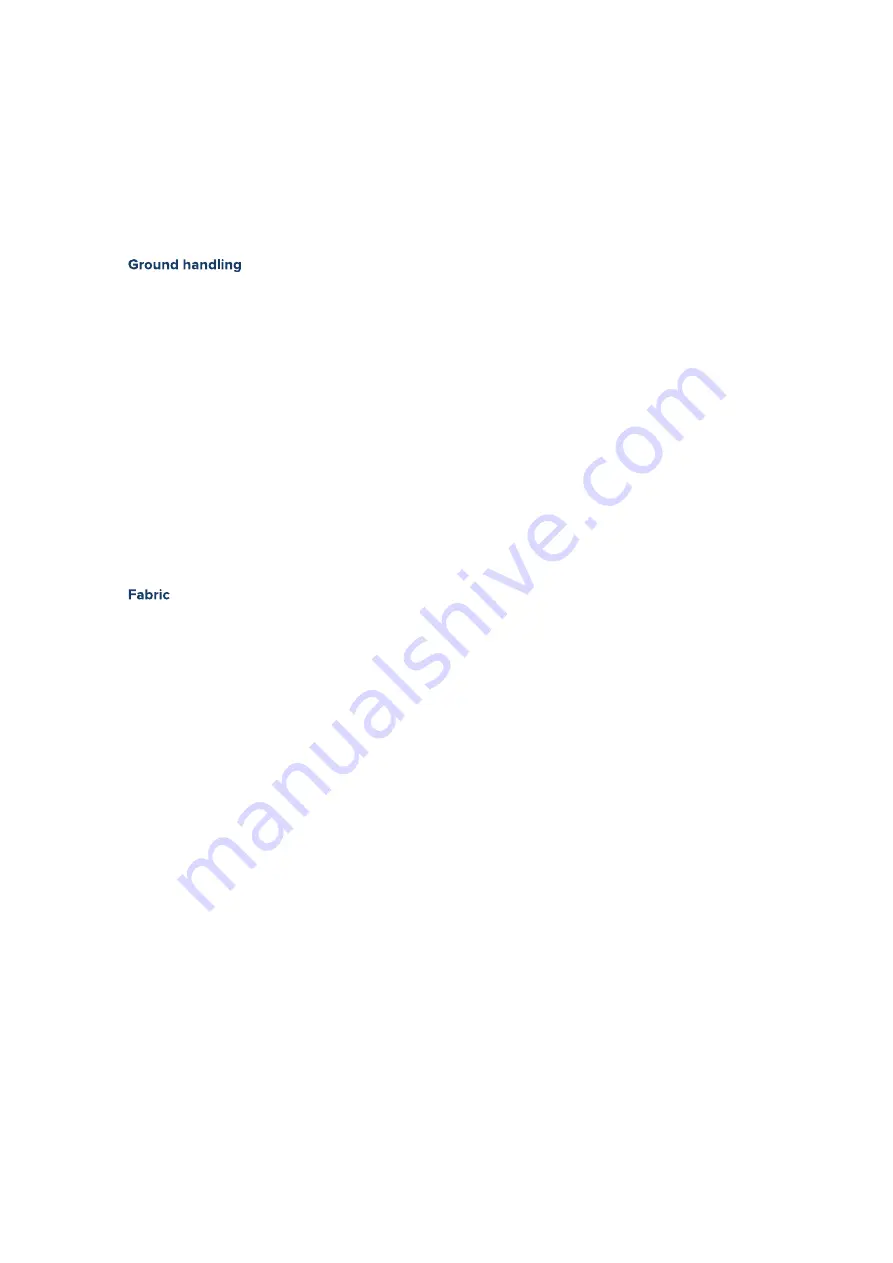
Bolero 7 user manual
_____________________________________________________________________________________________________________________________________
Care
The materials used in the Bolero 7 have been carefully selected for maximum durability and
performance. Nevertheless, following the guidelines below will keep your paraglider airworthy and
will ensure a long period of continuous safe operation. Excessive wear is caused by careless ground
handling and packing, unnecessary exposure to UV light, chemicals, heat and moisture.
The following should be avoided:
Ɣ
Don’t ground handle or take-off on abrasive surfaces.
Ɣ
To move the paraglider to another spot, don’t drag it across the ground. Pick it up and carry it.
Ɣ
Violent shocks to the canopy (e.g. when the canopy crashes to the ground leading edge
fi
rst
whilst ground handling). This stresses the seams and can even cause the cell to explode.
Ɣ
Don’t repeatedly in
fl
ate the glider and allow it to crash back down. Step towards the wing as it
comes down to take the force out of this action.
Ɣ
Dragging the glider along the ground.
Ɣ
Stepping on the lines or canopy. The Kevlar line inside the sheath can take lots of pulling
force without stretching, but is sensitive to bending with small radius.
Ɣ
Opening your wing in strong winds without
fi
rst untangling the lines.
Ɣ
Don’t sit on your rucksack when your glider is packed inside.
Care is essential to ensure that the fabric and glider remain durable and retain their qualities. The
glider should therefore be protected from unnecessary UV light. Do not unpack your glider until
immediately before
fl
ight and pack it up straight after landing. Modern paraglider fabrics have better
protection against the sun, but UV rays in particular are still one of the decisive factors in how the
fabric ages. The colours will fade
fi
rst and then the coating and
fi
bres will begin to age.
When choosing a place to launch, try to
fi
nd somewhere which is smooth and free of stones and
sharp objects. Do not stand on the glider. This weakens the fabric, especially if it is on a hard or stony
surface. Pay attention to the behaviour of spectators at the launch site, especially children: do not
hesitate to draw their attention to the sensitive nature of the fabric.
When you are packing up your glider, make sure that there are no insects trapped inside. Many
insects produce acids when they decompose, which can cause holes in the fabric. Grasshoppers
make holes by biting through the fabric and also excrete a dark liquid which stains. Keep animals
away when you are packing up. Insects are not attracted by any particular colours, contrary to what is
commonly believed.
If the glider gets wet or damp, it should be dried as soon as possible in a well-ventilated room (but
out of the sun). It may take several days before the canopy has dried completely because the
fi
bres
absorb water. Mould may form if the paraglider is stored wet and the
fi
bres may rot, particularly when
it is warm. This can make the paraglider unsuitable for
fl
ying within a short time.
A brand-new glider will often be compressed when delivered. This is solely for the initial delivery
and the glider should not be compressed in such a way again. Do not pack your glider too tightly after
use and, even though it is very comfortable, never sit on the backpack with the glider inside.
If salt water gets on the glider, it should be rinsed immediately in fresh water (refer to the section
“Cleaning”).
Page 28
Summary of Contents for Bolero 7
Page 1: ... v1 0 February 2022 ...
Page 45: ... www gingliders com ...
Page 46: ... v1 0 Février 2022 ...
Page 92: ... www gingliders com ...
















































